The growth of water trees in XLPE cable’s insulation
30. September, 2013, Autor článku: Skoršepová Terézia, Elektrotechnika
Ročník 6, číslo 9  Pridať príspevok
Pridať príspevok
![]() Degradation process on a cable insulation represent a large problem in cable engineering. We focused in paper on problematic of water and growth of water trees in insulation system of high voltage cables. This paper is focused on creation and growth of trees and is written of factors of creation of water and electrical trees. Next part is focused on types of water trees and their properties.
Degradation process on a cable insulation represent a large problem in cable engineering. We focused in paper on problematic of water and growth of water trees in insulation system of high voltage cables. This paper is focused on creation and growth of trees and is written of factors of creation of water and electrical trees. Next part is focused on types of water trees and their properties.
Introduction
For cable engineering is a large problem water in insulation systems. High voltage cable and other cables are exposed to water and moisture in general condition. Water action on cable insulation system causes changes in their properties and creates trees. In general, we can say that, water trees are diffuse structures in an insulating material resemble to a bush or to a fan, that are growing in many different kinds of polymers. Long time effect of water on insulation system causes form of water trees. This phenomena was described by Whithead in 1932.
A long time was considered by laboratory appearance and do not occurring in real praxis. This phenomenon has unfavourable effect to distribution of electric field in cable insulation and causes reduction of cable’s lifetime. In general, infiltration of water to cables represents a large problem. For example, in HV cables is used watertight tape. Interest in water trees growth in polymeric insulation has been extensively examined since the early 1973. However, the mechanism of growth is still the subject of active research. [1][2] We will concentrate in this article on insulation of cross-linked polyethylene.
Growth and existence of water trees
Water trees are dendritic patterns which grow in hydrophobic polymers in the presence of AC electric field and water. We can call water trees electrochemical trees as well. [4] Treeing in extruded dielectric cable insulation is the term that has been given to a type of electric deterioration that has the general appearance in a tree-like path through the wall of insulation. This formation is radial to the cable axis and hence is in line with the electrical field. Trees that create in insulations such as polyethylene, cross-linked polyethylene and ethylene propylene rubber cables are considered as two distinct types. It is water and electrical trees.
The amount of water in water trees is higher than the amount of water in the unaffected surrounding insulation. [2] Water trees are generally described as a permanent damage, unsurprisingly filled with water (and an array of accompanying salts and ions) which can cause a significant reduction in the breakdown strength of an affected cable. In particular, it has been shown that the breakdown strength of a cable is inversely proportional to the length of the longest vented tree existing in the insulation. [5] When these trapped charges are disturbed by heat or mechanical motion, they can literally bore a hole through the insulation wall.
Another factor is presence of ion particles. We know that voltage stress and temperature accelerates water trees propagation. [2] Water trees grow at a slower that may take years to propagate and grow. Their appearance is sometimes obvious upon cutting wafers from aged cables, but their visibility stems from the staining of the interior of the tree wall by some form of chemical staining. Non-stained water trees disappear when the sample is dried. Water treeing is influenced by the following: moisture, voids, contaminants, ionic impurities, temperature, temperature gradient, aging time, voltage stress or pH. [2]
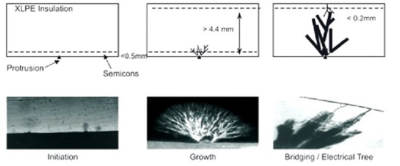
Fig. 1 Growth of water tree in XLPE insulation. [3]
The growth of water trees might in three steps. This process we can see on the Fig.1. First step or initiation of growth water trees is, because insulation can be uneven and second example can be contaminated of insulation. Next step is lone growth of water tree, but we have to say, that initiation of growth of water tree is necessary presence moisture in ppm level. Presence of water and growth of trees transform distribution of electric field and causes electrical stress in insulation.
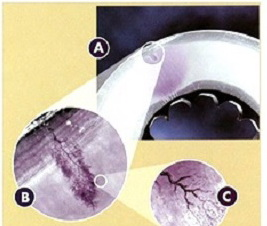
Fig. 2 Microphotography of water tree in the polyethylene insulation (http://electronicstructure.wikidot.com/density-functional-analysis-of-impurities-in-dielectrics)
For the growth of water trees is necessary water. Water trees have discreet voids separated by insulation systems. Water trees grow very long. It should be sometimes some months but also year. [2]
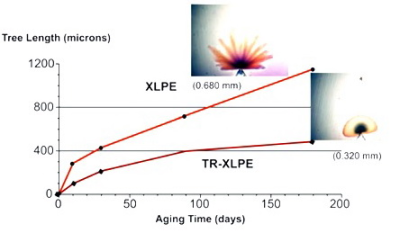
Fig. 3 Example growth water trees in XLPE(test) [3]
Vented trees
We know two different types of water trees. It is vented and bow trees. They have different form. The vented tree is defined as growing from the insulating material boundaries to the other side of the insulation, predominantly along the axis of the electric stress. The origin of vented tree initiation is in many cases difficult to find, however, the origin is sometimes mechanical damage of the cable insulation. Scratching of the insulation may for instance initiate treeing. Another origin of vented tree initiation can be an irregularity in the semiconducting screen where is bad contact with the insulation. [1]
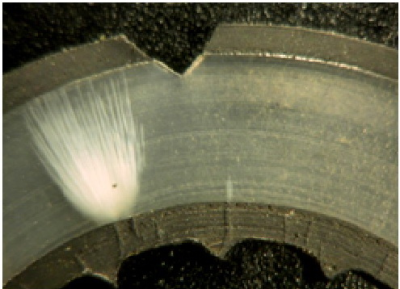
Fig. 4 Example of ”porous” (indicated by the white arrow) structures with a long vented water tree growing from the conductor screen in a service aged XLPE MV cable after heating the slice in water. Note that no water trees grow from the cracks/structures that do not bridge the conductor screen. [7]
If aged under moderate service conditions (up to a few kV/mm), a vented tree grown from the outside of the insulation and they are pencil-like. Trees grown from the inside have branches that spread a little bit more, although the distinct branches of large vented trees are pencil-like as well. In an insulating material which is fairly water tree susceptible, vented trees should reach the other side of the insulation (in 10 kV cables about 4 mm thick) in about 7 years. It has been found that this type of water tree has been responsible for many cable failures. [1]
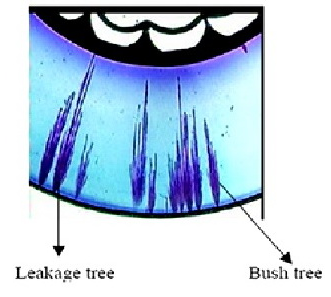
Fig. 5 Example of vented trees in HV cable [8]
On the Fig. 5 is typical example of vented trees. We show leakage of tree during insulation of cable.
Bow- tie trees
The other type of water tree is the bow-tie tree. Bow-tie trees are defined as initiating in the insulation volume. These trees grow in opposite directions, along the electric field lines. Normally the growth of this type of tree is strongly reduced after a certain time. The total length is restricted and therefore this kind of water tree is almost never the origin of cable breakdown. There are indications that the length of bow-tie trees is related to the size of the location containing the impurities. [2]
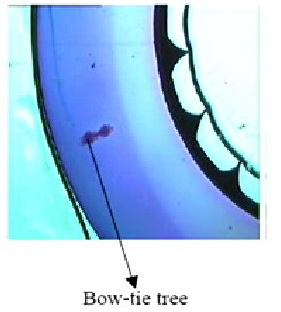
Fig. 6 Example of bow – tie tree [9]
In near surface of insulation is transformation of bow-tie tree. They grow from insulation outwards towards the surface of the insulation. These trees grow in the direction of the electric field in both directions. If we measure growth of vented trees and bow-tie trees, bow-tie trees have quicker initiatory growth in comparison with vented trees. Bow-tie trees are not able to grow to large size. Usually, they do not cause large insulation failures.
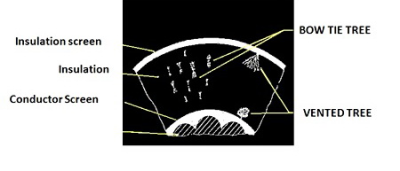
Fig. 7 Schematic water trees description (bow – tie trees and vented trees) in HV cable [9]
On the Fig.7 we show schematic description of water trees occurrence in insulation system. There is showed difference between place of bow-tie trees occurrence and vented trees occurrence. Bow-tie trees are in central insulation and vented trees we show on interface of insulation screen and insulation. Second example for vented trees is interface of conductor screen and insulation, what is showed in bottom part of the figure.
Conclusion
Water entering in high voltage cable cause water trees growth, within the insulation by microcracks gets to the core respectively by insulation shield. Trees create in isolation something like a needle and through this disturb electric field distribution in cable. In a similar way are generated electrical trees. The mechanism is local degradation of material which becomes conductive and changes the electric field distribution in the insulation.
References
- Steennis E. F. (1989) Water treeing the behaviour of water trees in extruded cable insulation, 201p,
- Thue W.A. (1999) Electrical Power Cable Engineering, 379p, Marcel Dekker, Hendersonville, North Carolina, U.S.A.
- Chavan, M.S., Ramachandran (2009). Water tree retandant (TR) -XLPE online:
http://msdssearch.dow.com/PublishedLiteratureDOWCOM/dh_0314/0901b80380314d05.pdf?filepath=wire/pdfs/noreg/310-12101.pdf&fromPage=GetDoc - Boggs, S., Densley, J. Kuang, J. (1998). Mechanism for impulse conversion of water trees to electrical trees in XLPE
- [5] Tapan A. J., Saha T. K. (2010) Diagnosing water tree degraded XLPE cables using Frequency Domain Spectroscopy
- [6] Seal, Robotic Cable (2004) Inspection system , Sensor technology, online:
http://www.ee.washington.edu/research/seal/projects/seal_robot/sensors.html - [7] Faremo H., Selsjord M., Hvidsten S., Bengtsson K., M., Ryen A. (2010), Initiation of Vented Water Trees from the Conductor Screen of MV XLPE Insulated Cables Conference Publications
- Dari Editor,. (2009) Water Tree in XLPE Cable
http://tnbelectricaleng.blogspot.sk/2009/12/water-tree-in-xlpe-cable.html - [9] Dari Editor,. (2009) Water Tree in XLPE Cable
http://tnbelectricaleng.blogspot.sk/2009/12/water-tree-in-xlpe-cable.html

